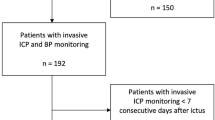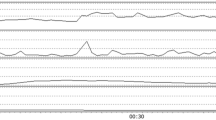Abstract
Background
Cerebrovascular pressure reactivity depends on cerebral perfusion pressure (CPP), with the optimal CPP (CPPopt) defined as pressure at which cerebrovascular reactivity is functioning optimally, reaching minimal value of pressure reactivity index (PRx). The study investigates the association between vasospasm, PRx, and CPPopt in poor grade patients (WFNS 4&5) after subarachnoid hemorrhage (SAH).
Methods
Data of intracranial pressure (ICP), arterial blood pressure (ABP), and flow velocities (FV) in the Middle Cerebral Artery (MCA) on transcranial Doppler from 42 SAH patients were analyzed retrospectively. PRx was calculated as a correlation coefficient between 10 s mean values of ABP and ICP calculated over a moving 3 min window. Data recorded during the first 48 h were available in 25 cases and during the first 3 days in 29 patients. Recordings obtained from day 4 to day 24 were available in 23 patients.
Results
PRx at optimal CPP measured during the first 48 h showed better cerebrovascular reactivity in patients who were alive at 3 months after ictus than in those who died (PRx value −0.17 ± 0.05 vs. 0.1 ± 0.09; P < 0.01). PRx below zero at CPPopt during the first 48 h had 87.5% positive predictive value for survival. CPPopt was lower before than during vasospasm (78 ± 3 mmHg, N = 29 vs. 98 ± 4 mmHg; N = 17, P < 0.0001). The overall correlation between CPPopt and Lindegaard ratio was positive (R = 0.39; P < 0.01; N = 45).
Conclusion
Most WFNS 4&5 grade SAH patients with PRx below zero at optimal CPP during the first 48 h after ictus survived. Optimal CPP increases during vasospasm.





Similar content being viewed by others
References
Linn FH, Rinkel GJ, Algra A, van Gijn J. Incidence of subarachnoid hemorrhage: role of region, year, and rate of computed tomography: a meta-analysis. Stroke. 1996;27:625–9.
Johnston SC, Selvin S, Gress DR. The burden, trends, and demographics of mortality from subarachnoid hemorrhage. Neurology. 1998;50:1413–8.
Heros RC, Zervas NT, Varsos V. Cerebral vasospasm after subarachnoid hemorrhage: an update. Ann Neurol. 1983;14:599–608.
Kassell NF, Torner JC, Haley EC Jr, Jane JA, Adams HP, Kongable GL. The international cooperative study on the timing of aneurysm surgery. Part 1: overall management results. J Neurosurg. 1990;73:18–36.
Pluta RM. Delayed cerebral vasospasm and nitric oxide: review, new hypothesis, and proposed treatment. Pharmacol Ther. 2005;105:23–56.
Schievink WI. Intracranial aneurysms. N Engl J Med. 1997;336:28–40.
Seiler R, Newell D. Subarachnoid hemorrhage and vasospasm. In: Newell D, Aaslid R, editors. Transcranial Doppler. New York: Raven Press; 1992. p. 101–7.
van Gijn J, Kerr SR, Rinkel GJ. Subarachnoid haemorrhage. Lancet. 2007;396:306–18.
Weir B, Grace M, Hansen J, Rothberg C. Time course of vasospasm in man. J Neurosurg. 1978;48:173–8.
Wintermark M, Ko NU, Smith WS, Liu S, Higashida RT, Dillon WP. Vasospasm after subarachnoid hemorrhage: utility of perfusion CT and CT angiography on diagnosis and management. AJNR Am J Neuroradiol. 2006;27:26–34.
Lysakowski C, Walder B, Costanza MC, Tramer MR. Transcranial Doppler versus angiography in patients with vasospasm due to a ruptured cerebral aneurysm: a systematic review. Stroke. 2001;32:2292–8.
Aaslid R, Huber P, Nornes H. Evaluation of cerebrovascular spasm with transcranial Doppler ultrasound. J Neurosurg. 1984;60:37–41.
Vora YY, Suarez-Almazor M, Steinke DE, Martin ML, Findlay JM. Role of transcranial Doppler monitoring in the diagnosis of cerebral vasospasm after subarachnoid hemorrhage. Neurosurgery. 1999;44:1237–47.
Steiner LA, Czosnyka M, Piechnik SK, Smielewski P, Chatfield D, Menon DK, Pickard JD. Continuous monitoring of cerebrovascular pressure reactivity allows determination of optimal cerebral perfusion pressure in patients with traumatic brain injury. Crit Care Med. 2002;30:733–8.
Tseng MY, Czosnyka M, Richards H, Pickard JD, Kirkpatrick PJ. Effects of acute treatment with pravastatin on cerebral vasospasm, autoregulation, and delayed ischemic deficits after aneurysmal subarachnoid hemorrhage: a phase II randomized placebo-controlled trial. Stroke. 2005;36:1627–32.
Lindegaard KF. The role of transcranial Doppler in the management of patients with subarachnoid haemorrhage—a review. Acta Neurochir Suppl. 1999;72:59–71.
Smielewski P, Czosnyka M, Steiner LA, Belestri M, Piechnik SK, Pickard JD. ICM+: software for on-line analysis of bedside monitoring data after severe head trauma. Acta Neurochir Suppl. 2005;95:43–9.
Krasznai L, Grote EH. Acute vasoparalysis after subarachnoid haemorrhage and cerebral trauma: general reflex phenomenon? Neurol Res. 1994;16:40–4.
Lam JM, Smielewski P, Czosnyka M, Pickard JD, Kirkpatrick PJ. Predicting delayed ischemic deficits after aneurysmal subarachnoid hemorrhage using a transient hyperemic response test of cerebral autoregulation. Neurosurgery. 2000;47:819–25.
Tran Dinh YR, Lot G, Benrabah R, Baroudy O, Cophignon J, Seylaz J. Abnormal cerebral vasodilation in aneurysmal subarachnoid hemorrhage: use of serial 133Xe cerebral blood flow measurement plus acetazolamide to assess cerebral vasospasm. J Neurosurg. 1993;79:490–3.
Voldby B, Enevoldsen EM. Intracranial pressure changes following aneurysm rupture. Part 1: clinical and angiographic correlations. J Neurosurg. 1982;56:186–96.
Lang EW, Diehl RR, Mehdorn HM. Cerebral autoregulation testing after aneurysmal subarachnoid hemorrhage: the phase relationship between arterial blood pressure and cerebral blood flow velocity. Crit Care Med. 2001;29:158–63.
Jakubowski J, Bell BA, Symon L, Zawirski MB, Francis DM. A primate model of subarachnoid hemorrhage: change in regional cerebral blood flow, autoregulation carbon dioxide reactivity, and central conduction time. Stroke. 1982;13:601–11.
Denny -Brown D. The treatment of recurrent cerebrovascular symptoms and the question of “vasospasm”. Med Clin North Am. 1951;35:1457–74.
Kassell NF, Peerless SJ, Durward QJ, Beck DW, Drake CG, Adams HP. Treatment of ischemic deficits from vasospasm with intravascular volume expansion and induced arterial hypertension. Neurosurgery. 1982;11:337–43.
Pickard JD, Boisvert DP, Graham DI, Fitch W. Late effects of subarachnoid haemorrhage on the response of the primate cerebral circulation to drug-induced changes in arterial blood pressure. J Neurol Neurosurg Psychiatry. 1979;42:899–903.
Iuliano BA, Pluta RM, Jung C, Oldfield EH. Endothelial dysfunction in a primate model of cerebral vasospasm. J Neurosurg. 2004;100:287–94.
Pluta RM, Thompson BG, Dawson TM, Snyder SH, Boock RJ, Oldfield EH. Loss of nitric oxide synthase immunoreactivity in cerebral vasospasm. J Neurosurg. 1996;84:648–54.
Aaslid R, Lindegaard KF, Sorteberg W, Nornes H. Cerebral autoregulation dynamics in humans. Stroke. 1989;20:45–52.
Giller CA. A bedside test for cerebral autoregulation using transcranial Doppler ultrasound. Acta Neurochir (Wien). 1991;108:7–14.
Czosnyka M, Smielewski P, Kirkpatrick P, Menon DK, Pickard JD. Monitoring of cerebral autoregulation in head-injured patients. Stroke. 1996;27:1829–34.
Soehle M, Czosnyka M, Pickard JD, Kirkpatrick PJ. Continuous assessment of cerebral autoregulation in subarachnoid hemorrhage. Anesth Analg. 2004;98:1133–9. table.
Balestreri M, Czosnyka M, Steiner LA, Schmidt E, Smielewski P, Matta B, Pickard JD. Intracranial hypertension: what additional information can be derived from ICP waveform after head injury? Acta Neurochir (Wien). 2004;146:131–41.
Steiner LA, Coles JP, Johnston AJ, Chatfield DA, Smielewski P, Fryer TD, Aigbirhio FI, Clark JC, Pickard JD, Menon DK, Czosnyka M. Assessment of cerebrovascular autoregulation in head-injured patients: a validation study. Stroke. 2003;34:2404–9. 34.
Acknowledgments
The authors are in debt to all the team participating in data collection : Mrs. Pippa Al-Rawi, Dr. Ming-Yuan Tseng, Mrs. Dott Chatfield, Mrs. Joanne Outtrim, Mrs. Anne Manktelow, Mrs. Helen Seeley, Mrs. Carole Turner, Dr. Marcella Balestreri, Dr. Magda Hiler, Dr. Luzius Steiner, Dr. Eric Schmidt, Dr. Stefan Piechnik, Dr. Andreas Raabe, Mr. Eric Guazzo, Prof. David Menon, Prof. Arun Gupta, Dr. Basil Matta, Mr. Peter Kirkpatrick, Mr. Ivan Timofeev, Mr. Pwawanjit Minhas, and all nursing and research staff of NCCU and Wolfson Brain Imaging Centre. The project was supported by National institute of Health Research Biomedical Research Centre, Cambridge University Hospital Foundation Trust—Neurosciences Theme and Senior Investigaor Award (JDP). PB was supported by “Fond de perfectionnement” of the Geneva University Hospital, The “Fond Ernst and Lucie Schmidheiny” and the “Société Académique de Genève”.
Disclosure
ICM+ software (www.neurosurg.cam.ac.uk/icmplus) is licensed by University of Cambridge and PS and MC have financial interest in a fraction of licensing fee.
Author information
Authors and Affiliations
Corresponding author
Rights and permissions
About this article
Cite this article
Bijlenga, P., Czosnyka, M., Budohoski, K.P. et al. “Optimal Cerebral Perfusion Pressure” in Poor Grade Patients After Subarachnoid Hemorrhage. Neurocrit Care 13, 17–23 (2010). https://doi.org/10.1007/s12028-010-9362-1
Published:
Issue Date:
DOI: https://doi.org/10.1007/s12028-010-9362-1




